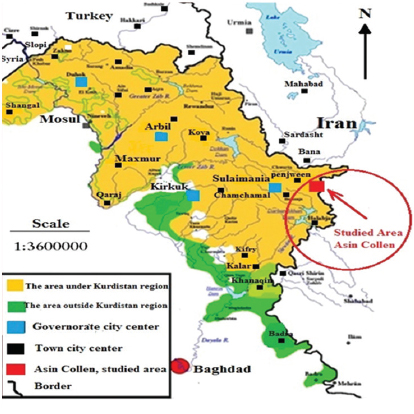Sir,
Asnawa is the name of the mountain near the Iraq-Iran border; it is located about 3 km to the east of Penjwen, a town belongs to Sulaymaniyah province in the Iraqi Kurdistan region.
In Kurdish vocabulary, Asnawa means a place where iron is rich in the area. The five iron quarries of Asnawa are located to the south-east of Penjwen town. A difficult unpaved road climbs through the Bilkian valley leads to the area of the iron ore which can be visited only by a four-wheel drive vehicle. The area is about 1350 m high in elevation and takes only half an hour from Penjwen to reach to the quarries. The areas surrounding the road and the quarries are dangerous as being full of remnants of weapons, especially minefields and different kinds of unexploded shells.
Mineralogical investigations in Asnawa and surrounding areas were neglected for more than 50 years; this was mainly due to the political unrest situation between Iraq and Iran. In fact, it was regarded as a prohibited area and has been almost guarded by Iranian troops. Uncertain news and rumors highlighted the presence of Uranium in the area.
With the exception of a limited number of reports and scientific papers which are mainly geological reviews, little information is available on the mineralogy of the area until recent years when few scientific papers published in different journals (Jassim and Goff, 2006; Al-Bidary, 2011; Yara, 2015; Kafoor and Mawloud, 2015; Kafoor, 2017).
McCarthy (1956) was the first researcher who investigated the occurrence of iron ore in Asnawa. He reported that the iron occurrence is situated in a complex zone of igneous and metamorphic rocks of uncertain age. Bolton (1958) mentioned in his report that the iron ore was found within metamorphic rocks in the Qandil series. During 1957–1959, the Site Investigations Company resumed its work on the Asnawa iron ore and estimated its quantity as around 250 thousand tons of iron.
Recent studies in Asnawa on <2 mm free-clay earth fractions indicated that the most noteworthy physical properties of the rocks are the color and magnetic force that pull other ferromagnetic minerals. The order of magnetic attraction force is varied from place to place. X-ray diffraction analyses tests taken from the five quarries showed that the main type of Fe oxide samples was magnetite, followed by hematite and wustite, constituting about 52.1% of the clay-free fine earth samples (Kafoor and Mawloud, 2015; Kafoor, 2017).
For more than 3000 years, and in most societies, people skilled iron as a useful tool in agriculture and defense. Its use became widespread in the 14th century in Europe, after forerunner of blast furnaces began to replace forges. Magnetite (Fe3O4) and hematite (Fe2O3) are usually found in iron ore rocks which are used to make iron in the form of steel.
The main possible reason for non-investment in Asnawa is the location. Asnawa is exactly located between the border of the most ever two disputed countries, Iraq and Iran. The political tensions between these two countries and inadequate capital and lack of technology have resulted in non-investment in the area.
Kurdistan region of Iraq is extremely ambitious in its efforts for advancing economy and industrialization, but unfortunately due to the political unrest with the surrounding countries this ambitious project has not been yet come true.
To study the economical utilization of Iron in Asnawa, the ministry of Natural resources of KRG with a team of experts and scientists have to study the net present value or net present worth to evaluate the feasibility of the iron ores then to conclude in a conclusive report whether the ore reserve is economically viable or not. Fully exploited can serve as a source of foreign exchange for the country (Bolton, 1958) [Figure 1 and Table 1].
Figure 1. Geographical location of Asnawa
Table 1. The latitude, longitude, and elevation of the five quarries in Asnawa

